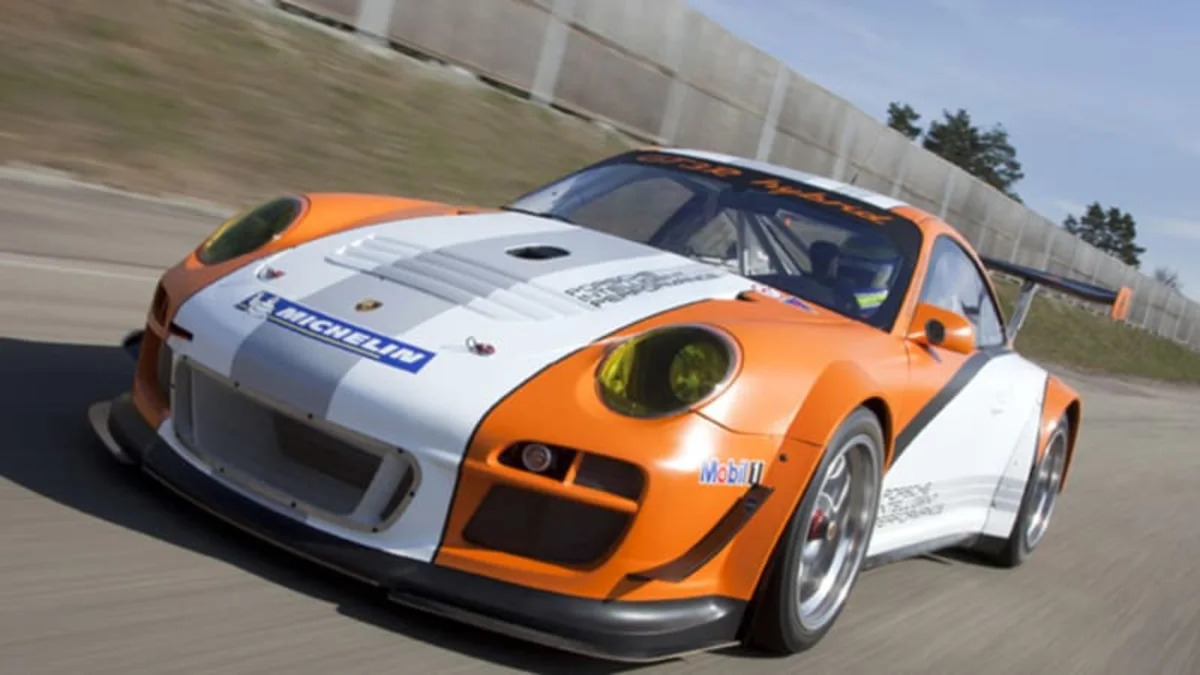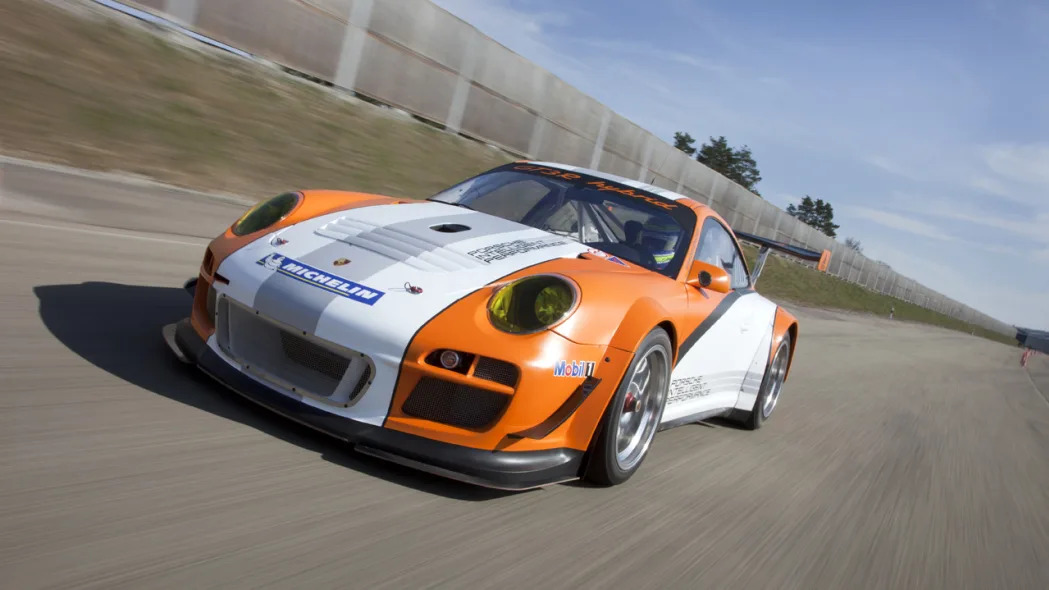Porsche 911 GT3 R Hybrid v2.0 - Click above for high-res image gallery
Porsche has pulled back the curtain on the second version of its 911 GT3 R Hybrid race car. The German automaker has managed to reduce the electrified racer's weight by mostly by toying with the hybrid drivetrain.
Two electric motors mated to a portal axle spin the front wheels with up to 200 horsepower for a few seconds at a time. That's in addition to the 470 horsepower on tap from the flat six-cylinder internal combustion engine mounted out back. Thanks to data collected during the previous generation 911 GT3 R Hybrid's time on track, which was extensive, engineers were also able to reconfigure the vehicle's high-voltage components and in the process, reduce the system's overall weight by 20%.
 Doing so allowed for the deletion of those massive air intakes on the rear fenders of the old body (right, at last year's 24 Hours of Nürburgring). The new skin is significantly more aerodynamic and helps deliver increased fuel economy as a result. The 911 GT3 R Hybrid still uses an electric flywheel accumulator, though it and the rest of the hybrid kit is now stored in a carbon-fiber safety cell on the passenger side of the cabin.
Doing so allowed for the deletion of those massive air intakes on the rear fenders of the old body (right, at last year's 24 Hours of Nürburgring). The new skin is significantly more aerodynamic and helps deliver increased fuel economy as a result. The 911 GT3 R Hybrid still uses an electric flywheel accumulator, though it and the rest of the hybrid kit is now stored in a carbon-fiber safety cell on the passenger side of the cabin.
Porsche plans to campaign the 911 GT3 R Hybrid 2.0 at various race events throughout the year, just like it did with the first car, starting with the Nürburgring 24 in June. Hit the jump for the full press release.
[Source: Porsche]
Porsche Takes on Nurburgring 24 with An Even More Efficient 911 GT3 R Hybrid
Stuttgart/Atlanta March 17-- Porsche AG will enter the Nürburgring 24 hour race on June 25, 2011, with a more advanced version of the Porsche 911 GT3 R Hybrid. The priority for this latest edition was improvement of efficiency through the targeted optimization of hybrid components, which also resulted in a 20 percent weight reduction. Version 2.0 of the 911 GT3 R Hybrid is intended to achieve the same lap times as its predecessor but with less fuel consumption.
The general layout of the hybrid was adopted from the 2010 model. A portal axle with two electric motors drives the front wheels and supplements the four-liter - depending on the balance of performance classification - approximately 470 hp, six-cylinder boxer engine at the rear. The output of both electric motors has increased from 60 to 75 kilowatts each. For bursts of multiple seconds at a time, drivers now have almost an additional 200 hp at their disposal with the 911 GT3 R Hybrid 2.0. Depending on the programming, this power is automatically activated through use of the throttle pedal. Moreover, pilots can manually call up this extra power, for instance when overtaking.
The electric flywheel accumulator, with its rotor spinning up to 40,000 rpm and storing energy mechanically as rotational energy, is now housed with the other hybrid components in a carbon fiber safety cell on the passenger's side.
At first glance, the new GT3 R Hybrid is clearly distinguishable from the 2010 model. Thanks to the optimization of the hybrid system's high voltage components, the large louvers in front of the rear fenders were no longer necessary. This reduces drag and also lowers fuel consumption. All in all, the weight of the vehicle decreased from 1,350 to 1,300 kilograms.
"We've collected a great deal of information from our races on the Nürburgring, at the ALMS race at Road Atlanta, as well as from the ILMC race on China's Zhuhai circuit. The data was invaluable for the further development of our racing laboratory," says Hartmut Kristen, head of Porsche motorsport. "The emphasis of our work was on improving efficiency. That means we want to keep the lap times consistent with 2010 but use less energy, hence less fuel. In this way, we support future developments of road-going, sporting hybrid vehicles."
The cockpit of the 911 GT3 R Hybrid has also been completely revised. Most of the displays and controls have moved to the steering wheel. Drivers can operate the rest of the functions via backlit buttons now situated on the centre console. Priority was placed on the ergonomics and the clear layout for pilots – particularly in darkness.
The new 911 GT3 R Hybrid is a perfect example of the 'Porsche Intelligent Performance' philosophy, a principle found in every Porsche - more power on less fuel, more efficiency and lower CO2 emissions – on the race track and on the road.
Stuttgart/Atlanta March 17-- Porsche AG will enter the Nürburgring 24 hour race on June 25, 2011, with a more advanced version of the Porsche 911 GT3 R Hybrid. The priority for this latest edition was improvement of efficiency through the targeted optimization of hybrid components, which also resulted in a 20 percent weight reduction. Version 2.0 of the 911 GT3 R Hybrid is intended to achieve the same lap times as its predecessor but with less fuel consumption.
The general layout of the hybrid was adopted from the 2010 model. A portal axle with two electric motors drives the front wheels and supplements the four-liter - depending on the balance of performance classification - approximately 470 hp, six-cylinder boxer engine at the rear. The output of both electric motors has increased from 60 to 75 kilowatts each. For bursts of multiple seconds at a time, drivers now have almost an additional 200 hp at their disposal with the 911 GT3 R Hybrid 2.0. Depending on the programming, this power is automatically activated through use of the throttle pedal. Moreover, pilots can manually call up this extra power, for instance when overtaking.
The electric flywheel accumulator, with its rotor spinning up to 40,000 rpm and storing energy mechanically as rotational energy, is now housed with the other hybrid components in a carbon fiber safety cell on the passenger's side.
At first glance, the new GT3 R Hybrid is clearly distinguishable from the 2010 model. Thanks to the optimization of the hybrid system's high voltage components, the large louvers in front of the rear fenders were no longer necessary. This reduces drag and also lowers fuel consumption. All in all, the weight of the vehicle decreased from 1,350 to 1,300 kilograms.
"We've collected a great deal of information from our races on the Nürburgring, at the ALMS race at Road Atlanta, as well as from the ILMC race on China's Zhuhai circuit. The data was invaluable for the further development of our racing laboratory," says Hartmut Kristen, head of Porsche motorsport. "The emphasis of our work was on improving efficiency. That means we want to keep the lap times consistent with 2010 but use less energy, hence less fuel. In this way, we support future developments of road-going, sporting hybrid vehicles."
The cockpit of the 911 GT3 R Hybrid has also been completely revised. Most of the displays and controls have moved to the steering wheel. Drivers can operate the rest of the functions via backlit buttons now situated on the centre console. Priority was placed on the ergonomics and the clear layout for pilots – particularly in darkness.
The new 911 GT3 R Hybrid is a perfect example of the 'Porsche Intelligent Performance' philosophy, a principle found in every Porsche - more power on less fuel, more efficiency and lower CO2 emissions – on the race track and on the road.



Sign in to post
Please sign in to leave a comment.
Continue